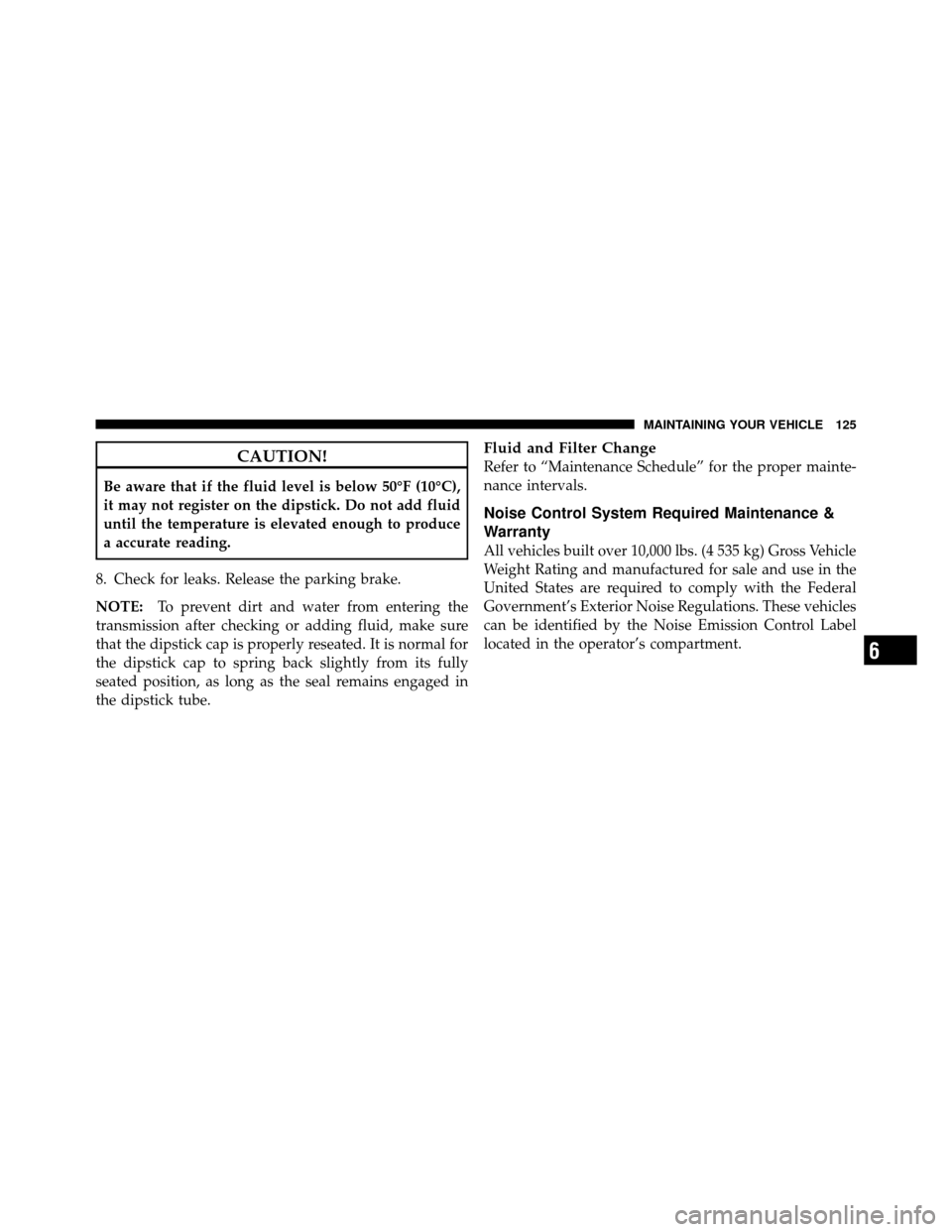2011 Ram 3500 light
[x] Cancel search: lightPage 120 of 170

•Keep the front of the radiator clean. If your vehicle is
equipped with air conditioning, keep the front of the
condenser clean.
•Do not change the thermostat for Summer or Winter
operation. If replacement is ever necessary, install
ONLY the correct type thermostat. Other designs may
result in unsatisfactory cooling performance, poor gas
mileage, and increased emissions.
Charge Air Cooler – Inter-Cooler
The charge air cooler is positioned between the radiator
and the air conditioner condenser. Air enters the engine
through the air cleaner and passes through the turbo-
charger, where it is pressurized. This pressurized air
rapidly reaches high temperature. The air is then directed
through a hose to the charge air cooler and through
another hose to the intake manifold of the engine. The air
entering the engine has been cooled by about 50° to 100°F
(10° to 38°C). This cooling process enables more efficient
burning of fuel resulting in fewer emissions.To guarantee optimum performance of the system, keep
the surfaces of the charge air cooler, condenser and
radiator clean and free of debris. Periodically check the
hoses leading to and from the charge air cooler for cracks
or loose clamps resulting in loss of pressure and reduced
engine performance.
Brake System
Brake Master Cylinder – Brake Fluid Level Check
The fluid level of the master cylinder should be checked
when performing under the hood service, or immedi-
ately if the “Brake System Warning Light” indicates
system failure.
The brake master cylinder has a translucent plastic
reservoir. On the outboard side of the reservoir, there is a
“MAX” mark and an “MIN” mark. The fluid level must
be kept within these two marks. Do not add fluid above
the full mark because leakage may occur at the cap.
6
MAINTAINING YOUR VEHICLE 119
Page 124 of 170

NOTE:If it is necessary to check the transmission below
the operating temperature, the fluid level should be
between the two “COLD” (lower) holes on the dipstick
with the fluid at approximately 70°F (21°C) (room tem-
perature). If the fluid level is correctly established at
room temperature, it should be between the “HOT”
(upper) reference holes when the transmission reaches
180°F (82°C). Remember it is best to check the level at the
normal operating temperature.
CAUTION!
Be aware that if the fluid temperature is below 50°F
(10°C) it may not register on the dipstick. Do not add
fluid until the temperature is elevated enough to
produce an accurate reading.
7. Check for leaks. Release parking brake. To prevent dirt and water from entering the transmission
after checking or replenishing fluid, make certain that the
dipstick cap is properly reseated. It is normal for the
dipstick cap to spring back slightly from its fully seated
position, as long as its seal remains engaged in the
dipstick tube.
Fluid Level Check – AS68RC (Chassis Cab Only)
Check the fluid level while the transmission is at normal
operating temperature. This occurs after at least 15 miles
(25 km) of driving. At normal operating temperature, the
fluid cannot be held comfortably between the fingertips.
To properly check the transmission fluid, the following
procedure must be used.
1. The vehicle must be on level ground.
2. Operate the engine at idle speed for a minimum of
60 seconds and normal operating temperature.
6
MAINTAINING YOUR VEHICLE 123
Page 126 of 170

CAUTION!
Be aware that if the fluid level is below 50°F (10°C),
it may not register on the dipstick. Do not add fluid
until the temperature is elevated enough to produce
a accurate reading.
8. Check for leaks. Release the parking brake.
NOTE: To prevent dirt and water from entering the
transmission after checking or adding fluid, make sure
that the dipstick cap is properly reseated. It is normal for
the dipstick cap to spring back slightly from its fully
seated position, as long as the seal remains engaged in
the dipstick tube.
Fluid and Filter Change
Refer to “Maintenance Schedule” for the proper mainte-
nance intervals.
Noise Control System Required Maintenance &
Warranty
All vehicles built over 10,000 lbs. (4 535 kg) Gross Vehicle
Weight Rating and manufactured for sale and use in the
United States are required to comply with the Federal
Government’s Exterior Noise Regulations. These vehicles
can be identified by the Noise Emission Control Label
located in the operator’s compartment.
6
MAINTAINING YOUR VEHICLE 125
Page 138 of 170

Oil Change Indicator System
Ram Truck Pick-Up (2500 and 3500 Models)
Your vehicle is equipped with an engine oil change
indicator system. This system will alert you when it is
time to change your engine oil by displaying the words
“Oil Change Due” on your Electronic Vehicle Informa-
tion Center (EVIC). The engine oil change indicator
system is duty cycle based, which means the engine oil
change interval may fluctuate depending on your per-
sonal driving style. Driving styles such as frequent stop
and go type driving or extended idle time can increase
the frequency of the engine oil change. This is the result
of more frequent regeneration of the exhaust after treat-
ment system, which can decrease the life of the engine oil.
Failure to change the engine oil per the maintenance
schedule can result in internal engine damage.For information on resetting the Oil Change Indicator
message, refer to “Oil Change Due” under “Electronic
Vehicle Information Center (EVIC)/EVIC Warning
Lights” in “Understanding Your Instrument Panel” for
further information.
When prompted by the Engine Oil Indicator System, the
engine oil and filter must be changed. If not prompted by
the Engine Oil Indicator System within 7,500 miles
(12 000 km) or six months since the last oil and filter
change, replace the engine oil and engine oil filter. Under
no circumstances should oil change intervals exceed
7,500 miles (12 000 km) or six months, whichever comes
first.
7
MAINTENANCE SCHEDULES 137
Page 163 of 170

Adding Fuel............................ 83
Air Cleaner, Engine (Engine Air Cleaner
Filter) ............................. 102,126
Air Filter .............................. 102
Airbag Light ............................ 19
Antifreeze (Engine Coolant) .............. 114,115
Capacities ........................... 130
Disposal ............................ 117
Anti-Lock Warning Light ................... 19
Automatic Transmission .................... 68
Adding Fluid ......................... 122
Fluid Level Check ..................... 122
Fluid Type ........................ 122,133
Shifting .............................. 62
Axle Fluid ............................. 133
Battery ............................... 112
Blanket ........................... 51,113
Emergency Starting ..................... 90 Brake Fluid
............................ 133
Brake System ........................... 119
Fluid Check .......................... 119
Master Cylinder ....................... 119
Warning Light ......................... 14
Brake/Transmission Interlock ................ 61
Calibration, Compass ...................... 33
Capacities, Antifreeze (Engine Coolant) ........ 130
Capacities, Fluid ........................ 130
Caps, Filler Oil (Engine) .......................... 100
Radiator (Coolant Pressure) ............... 116
Charge Air Cooler ....................... 119
Check Engine Light (Malfunction Indicator
Light) ................................. 18
Compass .............................. 32
Compass Calibration ...................... 33
Compass Variance ........................ 33
162 INDEX
Page 165 of 170

Jump Starting......................... 90
Oil .............................. 98,131
Oil Filler Cap ......................... 100
Oil Synthetic ......................... 102
Runaway ............................. 81
Temperature Gauge ..................... 11
Exhaust Brake ........................... 58
Exhaust System ......................... 126
Filters Engine Fuel .......................... 104
Engine Oil ...................... 98,102,131
Flashers Turn Signal ........................... 11
Fluid, Brake ........................... 133
Fluid Capacities ......................... 130
Fluid Level Checks Brake ............................... 119
Manual Transmission ................... 121 Transfer Case
......................... 121
Fluids, Lubricants and Genuine Parts .......... 131
Fog Lights ............................. 19
Fuel ................................ 81,83
Adding .............................. 83
Conserving ........................... 30
Diesel .......................... 81,83,131
Filter ............................... 104
Gauge ............................... 11
Requirements .......................... 81
Saver Mode ........................... 30
Specifications .......................... 82
Tank Capacity ........................ 130
Gasoline (Fuel) Conserving ........................... 30
Gauges Coolant Temperature .................... 11
Fuel ................................ 11
164 INDEX
Page 166 of 170

Oil Pressure........................... 13
Speedometer .......................... 12
Tachometer ........................... 11
Voltmeter .......................... 14,49
Gear Ranges ........................ 64,69,75
Idle Up Feature .......................... 53
Information Center, Vehicle ................. 21
Instrument Cluster ...................... 10,11
Intervention Regeneration Strategy ........... 109
Jump Starting ........................... 90
Lights Airbag .............................. 19
Anti-Lock ............................ 19
Brake Warning ......................... 14
Check Engine (Malfunction Indicator) ........ 18
Electronic Stability Program (ESP) Indicator .... 20Fog ................................. 19
High Beam
........................... 14
High Beam Indicator .................... 14
Instrument Cluster ...................... 11
Seat Belt Reminder ...................... 20
Tire Pressure Monitoring (TPMS) ............ 16
Traction Control ........................ 20
Warning (Instrument Cluster Description) ...... 11
Locks Steering Wheel ......................... 6
Maintenance Procedures .................... 98
Maintenance Schedule .................... 136
Manual Transmission ...................... 74
Fluid Level Check ..................... 121
Lubricant Selection ..................... 133
Shift Speeds ........................... 75
Mini-Trip Computer ...................... 30
8
INDEX 165
Page 168 of 170

Resetting Oil Change Indicator............... 27
Resetting Perform Service Indicator ........... 138
Seat Belts Reminder ............................ 20
Selection of Coolant (Antifreeze) .......... 114,131
Settings, Personal ........................ 34
Shifting ............................... 60
Automatic Transmission .................. 62
Manual Transmission .................... 74
Signals, Turn ............................ 11
Speedometer ............................ 12
Starting ............................... 44
Automatic Transmission .................. 44
Engine Block Heater ................... 44,57
Manual Transmission .................... 44
Starting Procedures ....................... 44
Starting Procedures (Diesel Engines) ........... 44Steering
Wheel Lock ............................ 6
Synthetic Engine Oil ...................... 102
Tachometer ............................. 11
Temperature Gauge, Engine Coolant ........... 11
Tip Start ............................... 44
Ti re s Pressure Warning Light .................. 16
Torque Converter Clutch .................67,73
Tow/Haul ............................. 66
Traction Control ......................... 121
Traction Control Light ..................... 20
Transfer Case Fluid ............................... 133
Transmission Automatic .......................... 62,68
Fluid ............................... 133
Manual ............................ 44,74
8
INDEX 167